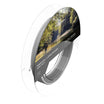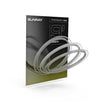Written by Ben Beckwith, England Youth Team member and avid UK fly fisher.
Manningford Trout Fishery near Pewsey Vale
There are a number of fishing lakes near me. One of my favourites is Manningford Trout Fishery in Wiltshire. Stillwater fishing can be very difficult, even stocked Manningford trout. I grew up stillwater trout fishing and fished in the England Youth Team. Fishing tickets at Manningford start at £25 for a Junior. I was on an adult ticket for £30 which gave me 2 fish if I chose to keep them.
This day, I decided to see how nymphs designed for river fishing would compare to flies like boobies and blobs! The humble nymph is a creature that can be found in various guises, and calls the various waterways that Britain has to offer; home. In the late 1950’s, Frank Sawyer designed many nymph replications for fly fishing on the famous English chalk streams found in England. Flies like pheasant tail nymphs and Sawyer killer bugs were used for brown trout on rivers for many years to great success and still work to the current day, with most patterns being modernised based on the new influxes of synthetic and modified natural materials. Yet the original designs still hold place in many traditional and modern anglers hearts. It wasn’t long after the flies were published that people started to dabble with them on the English still-water’s around the UK. It seemed that patterns designed for wily river trout found great success on the still-water’s too and the patterns were transferrable across water types. Similar patterns still have success to this day, and on a trip to Manningford I looked to see how transferrable more modern-day river patterns are when compared with the old faithful’s.
Upon arrival to the fishery at about mid-day, which was undeniably later than planned but early for any student, I was greeted by bright sun, intermittent clouds and a smiling Malcolm Hunt, the fishery manager. After a brief chat and a look around the fishery, I realised that a mid-day arrival was a bit of a ‘faux pas’ as most pegs were taken and the fish had received a lot of pressure. Yet rods continued to bend as I setup, so I started the day with confidence. My set up was a 9ft 6in 6w, coupled with a nautilus 6w reel and the new 6w Sunray Competition floater, culminating in a small olive quill jig fly. I know that the original pheasant tails would catch plenty of fish, but the point of the day was to see how more modern flies faired. The key difference being that I was fishing a jig nymph on a small Stillwater. The hook point is designed to ride up so it doesn’t hook the bottom of the river, so I was interested to see whether it would make any difference on the lakes.
Due to how busy the lake was, I decided to start the day at the far end of the lake near the outlet where I know from previous trips a lot of the larger trout like to hang around. I began the day peering over the various casting platforms searching for standing fish that I could cast to. It didn’t take long for me to see a good size rainbow trout sat under an overhanging bush. The awkward position meant I had to pull out my finest impression of a ballet dancer to reach over the bush and flick the fly in front of the bush. The fish’s initial refusal was heart breaking after I had made a fool of myself in my attempt to get my fly close to him. However, a re-cast and gentle twitches with the rod saw the fly make short jigs up and down and the fish rushed the fly and engulfed it. However, due to the position of the fish and me still with one leg in the air reaching over, I begged to whomever was watching over me not to let me fall in! Yet, after some rather creative moves and nail-biting moments the tremendous scrap finished with a fantastic warhorse of a rainbow in the net.

Happy days! But, when fishing I often go by the saying of 1 is a fluke, 2 is a coincidence and 3 is a method. As such, I still had to get 2 more on the river nymphs.
This rainbow trout was no beast, but this fin perfect specimen is testament to the quality of Manningford trout, which are reared and grown on site at their own fish farm. If a fish isn’t to standard it doesn’t get stocked. As such every fish found in the lakes are pristine and fight like demons.
The right fly line for Manningford Fishery
Soon after I landed the fish, the area went a bit quiet as the fish had been pushed out due to the pressure of the morning. This is where the new Sunray Competition fly line came into fruition. With minimal effort I was able to easily reach the islands where many larger fish patrol, and often require a more imitative approach for success. As such I set my sights on something a bit bigger. Due to the clarity of the water, in between cloudy periods I was able to spot some of these larger fish that Manningford is known for. After multiple casts targeting fish were left fruitless a change of fly was called for. Off went the quill nymph and on went a weighted pheasant tail jig nymph variant that I have been playing around with in recent months.
A change of fly was also followed by a change of approach. Instead of targeting specific fish, I decided to blind cast and cover more water, still focusing on the areas where the bigger fish should be. The new Sunray Competiton fly line made reaching the islands effortless with pin point accuracy. I started with a varied figure of eight to spark a bit of life into the fly, and after 20 or so minutes of covering water the line was ripped from my hand and after a few seconds I knew I had something a bit special on the end of the line! The fish ran me all over, nearly hitting backing on multiple occasions! It seemed as if the fish had been hooked before as it knew exactly where to run. It went for every possible snag it could find, whether it be overhanging trees or underwater roots. Yet after a nail biting few minutes, a pristine 9lb rainbow trout graced the back of my net.

A proper Manningford specimen trout. Admittedly not the biggest fish in the lake, as Malcolm stocks fish to 20lb, but a fully finned and stunning example of the quality that Manningford fishery offers. The pheasant tail jig had been engulfed and was hooked perfectly and held strong even through the long powerful runs of the fish. With 2 cracking trout for the day, the river nymphs seemed to be proving their worth on the lakes too.
What Manningford trout eat.
After landing my second cracker of the day a couple of anglers came up and asked me what I was using. I responded with river nymphs and was met with a look of complete bemusement, so I showed them. I got my box out and showed them the jigs and various shrimp style flies. At first, they didn’t believe that I had caught such large fish on such small flies. So, I spooned the first fish to show them what the fish had been eating. The fish was full of a variety of small and large buzzers as well as a variety of other small and mostly unidentifiable insects as a result of digestion. Once I put my flies next to the stomach contents of the fish it was clear that they matched the hatch, to a fair extent and when the fishing got slower a more imitative approach seemed to be more effective at picking out the better fish. Arguably lures would still take fish throughout the day, but it is likely that it would be more difficult due to pressure that had been put on the fish. Soon after both anglers put away the lures and swapped to nymphs and their rods began to bend once again.
Why do lures work for trout when they seldom represent natural aquatic life?
There are many alternative theories to suggest why, but one that I personally agree with is the idea that fish don’t have hands and as such they have to determine whether items are food by…well…eating them. It is likely that the fish are attracted to the lures presented to them and as such are left with a decision to make. In the edited words of William Shakespeare, To eat or not to eat, that is the question. I am under no illusion that lures have their place in every anglers box and trust me I am no different! In the immortal words of my good friend Charles Jardine, “Ben your lure box is simply unholy”. However, when fish get used to them on a day they often switch off, especially fish that have been caught before. As such, why not make a change and tie on exactly what the fish are eating. Fishing nymphs may not be as fun as ripping blobs and boobies, or bright lures through the water on various floating and sinking flylines at various paces, but they sure have their place and often pick out the better and more resident trout.
I continued to fish around the back corner of the lake for the rest of the day. The reason for this was that it had received a lot of pressure in the morning and as such most fly anglers had left the area due to the fish wising up so to speak. Thus, I had access to a lot of fish that had now been rested for the most part of 2-3 hours. Long enough time for them to settle a bit and for me to land a few more.

My approach was mostly unchanged, with the same small pheasant tail jig. However, after I made a few blind casts I soon realised that there were a number of larger fish cruising by my feet. Seeing as most fish often follow the same patrol route generally having a route that they like to follow. As such, I waited for the fish to come back to me. About 5 minutes later I saw a pair of fish swim towards me on the same line. They had returned! Seeing as they were around 2-3 foot down and moving fairly slowly through, I flicked the fly about 4 foot in front of the first fish. The fly dropped down to them and the second fish rushed the fly before turning away at the last second leaving me with my heart in my mouth. I let the fish go past the fly so not to spook them when I pulled it from the water to recast. As I went to flick the fly ahead of them again the sun went behind the clouds and I was no longer able to see the fish. I cast again a little further ahead than I thought necessary and began a very slow figure of eight retrieve just to keep in touch with the fly as I could not see the fish or their reaction. A few moments later the line went tight, and all hell broke loose! The fish took off up the lake, jumping and splashing as it went. Just as it was about to hit backing it decided to turn and come straight back for me, leaving me running backwards and desperately stripping line to try and keep it tight. After another tremendous couple of minutes of acrobatics and runs the fish was in the net, and it was yet another classic Manningford Trout. This time a solid Blue Trout of around 7lb.

What are the best stillwater trout flies?
And number 3 marked the method. River nymphs on the lake were no longer effective by coincidence, and three cracking fin perfect Manningford Rainbow and Blue Trout proved that. River patterns such as pheasant tails have been around for decades and are incredibly successful patterns. So, I suppose it comes down to this…are river flies better on lakes than your standard stillwater patterns? In honesty I wouldn’t say they were any more successful than your general-purpose stillwater flies, but they certainly have their place if you want to have a bit of fun with some more imitative flies. They’ll never out-fish lures when trout are in the mood to eat them, but its certainly good fun to mess around with nymphs and they certainly catch big fish! I concluded the day with 5 fish ranging between 4 and 9lb. What a cracking day fishing a lake near me.
































